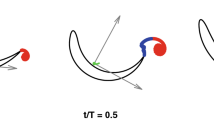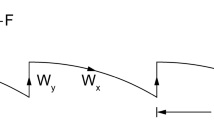Abstract
An observer may wonder whether a school of ‘running’ dolphins, consisting of numerous, wildly splashing individuals, is using the most efficient mode of locomotion, because splashing wastes energy. Dolphins exhibit at least three modes of swimming. In leisurely, unhurried motion, they break the surface briefly and gently, often showing little more than the blowhole. At a faster, ‘cruising’ speed, frequently at 3–3.5 ms−1 (6–7 knots), the animals are seen swimming primarily just beneath the surface, and there is still little splashing. (Behaviour and speeds of dolphin schools were observed from a helicopter and will be described elsewhere by D. A. and W. Ferryman.) Swimming speeds in this mode have been measured up to 4.6 ms−1 (9.3 knots). But in the fastest ‘running’ mode, the animals clear the water in sequential, parabolic leaps, accompanied by considerable splashing on exit and re-entry (Fig. 1). Leaps are interspersed with relatively brief, subsurface swimming. This swimming is common when dolphins are alarmed by vessels approaching within 500 m. We have examined dolphin swimming in terms of energy required per unit distance travelled and report here that beyond a certain ‘crossover’ speed, leaping must be more efficient than swimming.
This is a preview of subscription content, access via your institution
Access options
Subscribe to this journal
Receive 51 print issues and online access
$199.00 per year
only $3.90 per issue
Buy this article
- Purchase on Springer Link
- Instant access to full article PDF
Prices may be subject to local taxes which are calculated during checkout
Similar content being viewed by others
References
Lang, T. G. in Whales, Dolphins and Porpoise (ed. Norris, K. S.) 410–432 (University of California Press, Berkeley, 1966).
Hoerner, S. F. Fluid Dynamic Drag, 400 (Hoerner, S. R, Midland Park, New Jersey, 1965).
Hertel, H. Structure, Form and Movement, 251 (Reinhold, New York, 1966).
Webb, P. W. Bull. Fish. Res. Bd Can. 190, 158 (1975).
Weihs, D. J. mar. Res. 31, 195–209 (1973); J. theor. Biol. 48, 215–229 (1974).
Gero, D. R. Am. Mus. Novit. 1601, 1–32 (1952).
Leatherwood, S., Evans, W. E. & Rice, D. W. The Whales, Dolphins and Porpoises of the Eastern North Pacific, 175 (Naval Undersea Center TP 282, 1971).
Leatherwood, S., Caldwell, D. K. & Caldwell, M. C., Whales, Dolphins and Porpoises of the Western North Atlantic 176 (NOAA Tech. Rep., NMFS Circ. 396, 1976).
Lang, T. G. & Pryor, K. Science 152, 531–533 (1966).
Norris, K. S., Stuntz, W. E. & Rogers, W. The Behavior of Porpoise and Tuna in the Eastern Tropical Pacific Yellowfin Tuna Fishery—Preliminary Studies, 86 (Nat. Tech. Inform. Serv. P8283970, 1978).
Author information
Authors and Affiliations
Rights and permissions
About this article
Cite this article
Au, D., Weihs, D. At high speeds dolphins save energy by leaping. Nature 284, 548–550 (1980). https://doi.org/10.1038/284548a0
Received:
Accepted:
Issue Date:
DOI: https://doi.org/10.1038/284548a0
This article is cited by
-
Context of breaching and tail slapping in Indo-Pacific humpback dolphins in the northern South China Sea
Behavioral Ecology and Sociobiology (2023)
-
Summing the strokes: energy economy in northern elephant seals during large-scale foraging migrations
Movement Ecology (2015)
Comments
By submitting a comment you agree to abide by our Terms and Community Guidelines. If you find something abusive or that does not comply with our terms or guidelines please flag it as inappropriate.



